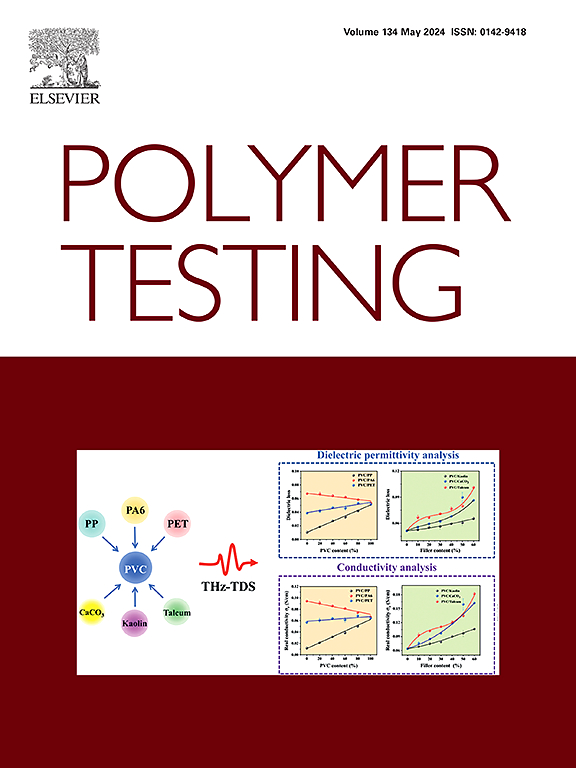Ultrasound-assisted fabrication of biodegradable and conductive PANI/sago/graphene hybrid nanocomposites for sustainable and flexible electronics
IF 6
2区 材料科学
Q1 MATERIALS SCIENCE, CHARACTERIZATION & TESTING
引用次数: 0
Abstract
The growing demand for high-performance portable electronic devices has intensified electromagnetic interference (EMI) pollution and electronic waste (e-waste), necessitating the development of sustainable conductive materials. This study introduces a novel ultrasound-assisted in situ oxidative polymerization method to fabricate polyaniline (PANI)/sago/graphene (PSG) hybrid nanocomposites. Morphological analyses (SEM and TEM) confirmed uniform dispersion of graphene nanoplatelets, spectroscopic studies (FTIR and UV–Vis) revealed enhanced molecular interactions, and thermal analysis (TGA) demonstrated superior thermal stability with a T50 of 497 °C. These interactions produced a low percolation threshold of 0.95 wt% GNP, a maximum DC conductivity of 3.44 × 10−1 S/cm, significantly surpassing that of PANI/Sago blend alone (2.17 × 10−3 S/cm). AC conductivity analysis revealed a broad plateau (102–106 Hz) via tunnelling and hopping mechanisms, with electrical performance retained up to 100 °C. These properties, combined with sago starch's biodegradability, position PSG nanocomposites as eco-friendly candidates for flexible electronics, EMI shielding, and biodegradable transient devices.
超声辅助制造可生物降解和导电聚苯胺/西米/石墨烯复合纳米材料的可持续和柔性电子
对高性能便携式电子设备日益增长的需求加剧了电磁干扰(EMI)污染和电子垃圾(e-waste),需要开发可持续的导电材料。介绍了一种超声辅助原位氧化聚合制备聚苯胺/西米/石墨烯复合材料的新方法。形态学分析(SEM和TEM)证实了石墨烯纳米薄片的均匀分散,光谱研究(FTIR和UV-Vis)显示了分子相互作用的增强,热分析(TGA)显示了优异的热稳定性,T50为497°C。这些相互作用产生了0.95 wt% GNP的低渗透阈值,最大直流电导率为3.44 × 10−1 S/cm,显著超过了聚苯胺/西米共混物(2.17 × 10−3 S/cm)。交流电导率分析显示,通过隧穿和跳变机制,交流电导率平台宽(102-106 Hz),电性能可保持到100°C。这些特性,再加上西米淀粉的可生物降解性,使PSG纳米复合材料成为柔性电子产品、EMI屏蔽和可生物降解瞬态器件的环保候选材料。
本文章由计算机程序翻译,如有差异,请以英文原文为准。
求助全文
约1分钟内获得全文
求助全文
来源期刊

Polymer Testing
工程技术-材料科学:表征与测试
CiteScore
10.70
自引率
5.90%
发文量
328
审稿时长
44 days
期刊介绍:
Polymer Testing focuses on the testing, analysis and characterization of polymer materials, including both synthetic and natural or biobased polymers. Novel testing methods and the testing of novel polymeric materials in bulk, solution and dispersion is covered. In addition, we welcome the submission of the testing of polymeric materials for a wide range of applications and industrial products as well as nanoscale characterization.
The scope includes but is not limited to the following main topics:
Novel testing methods and Chemical analysis
• mechanical, thermal, electrical, chemical, imaging, spectroscopy, scattering and rheology
Physical properties and behaviour of novel polymer systems
• nanoscale properties, morphology, transport properties
Degradation and recycling of polymeric materials when combined with novel testing or characterization methods
• degradation, biodegradation, ageing and fire retardancy
Modelling and Simulation work will be only considered when it is linked to new or previously published experimental results.
 求助内容:
求助内容: 应助结果提醒方式:
应助结果提醒方式:


